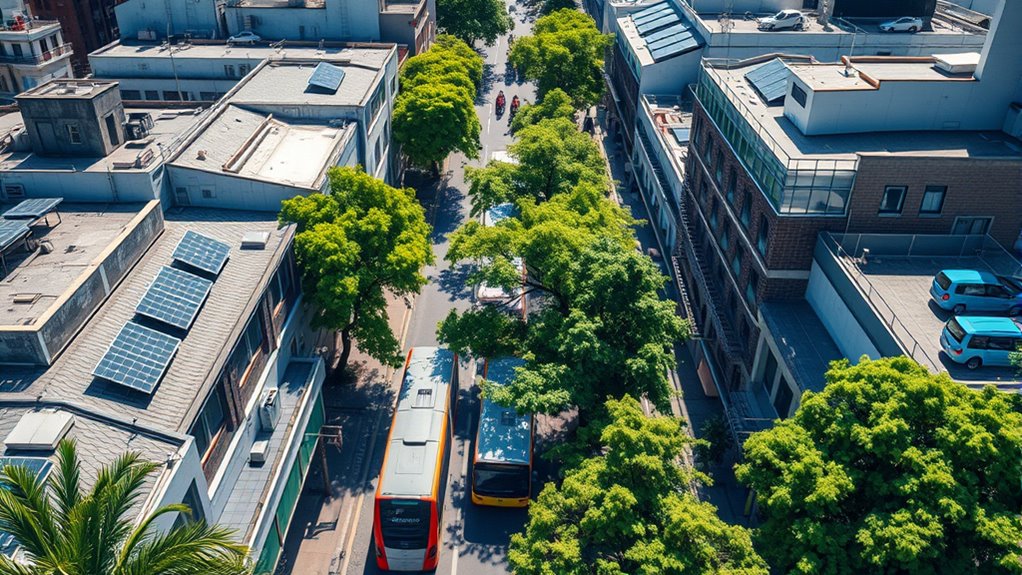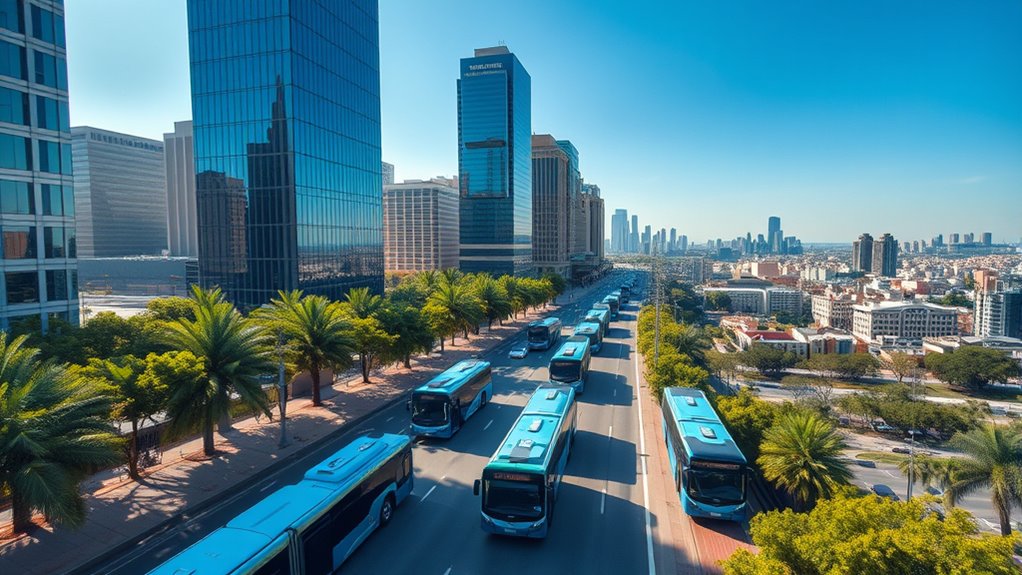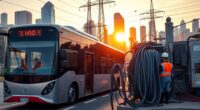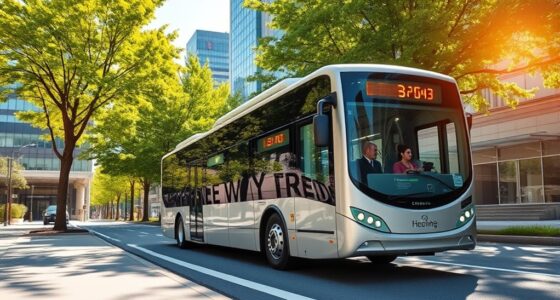Electric buses help reduce urban heat islands by emitting less waste heat and lowering overall city temperatures. As you see more electric buses, the heat absorbed by roads and buildings decreases, making your city cooler and healthier. This also improves air quality and reduces the need for cooling in buildings during hot days. To discover how broader changes and policies can amplify these benefits, keep exploring the ways electric transportation transforms urban environments.
Key Takeaways
- Electric buses produce less waste heat, directly reducing urban heat island intensity.
- Transitioning to electric buses lowers city temperatures by approximately 0.25°C or more.
- Reduced tailpipe emissions improve air quality, especially during heatwaves, benefiting public health.
- Less heat absorption by infrastructure decreases overall urban heat retention.
- Supporting infrastructure and green spaces amplify the heat mitigation effects of electric bus adoption.

Electric buses are transforming urban transportation by substantially reducing the heat generated within city environments. Unlike traditional buses powered by combustion engines, electric buses produce significantly less waste heat, which directly impacts the urban heat island effect. This effect occurs when cities become warmer than surrounding rural areas due to heat from vehicles, infrastructure, and dense built environments.
Electric buses significantly cut city heat, helping mitigate urban heat island effects.
By installing electric buses, you help lower the heat released into the atmosphere, easing the pressure on urban cooling systems and improving overall climate conditions. Reducing waste heat from buses also improves air quality, since electric models emit no tailpipe pollutants like particulate matter and ozone precursors. When cities shift to electric public transportation, they not only cut greenhouse gases but also create healthier environments.
Less heat from vehicles means less heat absorption by asphalt and concrete, which are major contributors to heat retention in urban areas. As a result, cities can experience temperature drops of around 0.25°C, as seen in places like the Greater Toronto Area. While a full transition could potentially reduce the urban heat island effect by up to 1°C, even modest improvements have tangible benefits for city residents.
The mechanisms behind the urban heat island effect include heat from vehicle exhaust and the heat-retaining properties of urban infrastructure. Traffic congestion and dense road networks contribute substantially to this problem. Transitioning to electric buses not only reduces emissions but also disrupts the urban heat island cycle, leading to cooler city environments.
Electric buses help mitigate this by cutting down the heat released during operation. However, to fully realize these benefits, urban planning must adapt, including the development of charging infrastructure and green spaces that further counteract heat absorption. Incorporating urban greening initiatives like parks and green roofs can further decrease heat retention and improve urban resilience. Additionally, the use of renewable energy sources for charging can enhance the environmental advantages of electric bus fleets.
Investing in smart grid technology can optimize energy use for charging stations, making the transition more sustainable. Installing charging stations and upgrading bus depots are essential steps to support widespread adoption.
Environmental benefits extend beyond temperature reductions. Electric buses eliminate tailpipe emissions, decreasing pollutants like nitrogen oxides and particulate matter that harm urban air quality. This improvement leads to healthier communities, especially during heatwaves, when heat stress and related health issues spike.
Additionally, lower urban temperatures reduce energy consumption for cooling buildings, further decreasing emissions and conserving resources.
Transitioning to electric buses does require investments in infrastructure and supportive policies. Cities need to plan for charging stations and depot upgrades to handle increased electric vehicle use.
Policy support accelerates adoption, encouraging manufacturers and transit agencies to prioritize electric fleets. These shifts influence urban planning, promoting sustainable transportation systems that align with environmental and public health goals.
Frequently Asked Questions
How Do Electric Buses Compare to Diesel Buses in Emissions?
You see, electric buses produce substantially fewer emissions than diesel buses, with up to 7.7 times lower lifecycle greenhouse gases depending on your region’s energy sources.
They cut direct emissions during operation by about 62%, and are roughly 70% more energy-efficient per mile.
As grids become cleaner, their emissions drop even further—potentially by 96%.
What Infrastructure Is Needed for Electric Bus Adoption?
You’re wondering what infrastructure is needed to adopt electric buses. You’ll need charging facilities like pantograph or inductive systems, which require space and high-power setups comparable to thousands of homes.
Upgrading your facilities involves installing high-capacity substations, possibly costing millions, and ensuring enough space for chargers and maintenance.
Planning for energy needs and integrating charging strategies are essential to smoothly shift your fleet to electric buses.
Can Electric Buses Operate Effectively in Extreme Weather Conditions?
Think of electric buses as a sailboat steering through a storm. While cold weather can reduce their range by up to 33%, with proper planning, they can still chart a course effectively.
Preheating, insulation, and optimized routes help overcome temperature hurdles. Though some may perform better in extreme cold, you can keep electric buses running smoothly by implementing these strategies, ensuring reliable operation in even the harshest conditions.
What Are the Long-Term Cost Savings of Electric Buses?
You can expect substantial long-term cost savings with electric buses. They save you up to $50,000 annually per bus on fuel, and over their lifetime, savings reach around $400,000.
Maintenance costs drop by $125,000–$170,000 because of fewer parts and repairs. Plus, incentives and revenue streams like vehicle-to-grid tech boost savings, making electric buses more economical within 5–7 years and reducing total ownership costs considerably.
How Do Electric Buses Impact Noise Pollution in Cities?
You might think electric buses would make cities noisier with all their tech, but surprise—it’s quite the opposite. Thanks to silent electric motors, regenerative braking, and lack of gear-shifting sounds, noise levels drop markedly—up to 4.4 dBA during busy hours.
This quiet revolution benefits residents, reduces stress, and even allows closer proximity of bus stops and dense housing. Who knew peace and quiet could be part of urban transit’s future?
Conclusion
Imagine electric buses as the cool breath of relief in a city’s fiery embrace, symbolizing hope and change. By replacing traditional buses, you help turn down the heat, easing the urban heat island effect. Every electric ride is like planting a shade tree—reducing warmth and brightening the city’s future. Together, your choices become the gentle wind that cools and refreshes, reminding us all that small actions can transform the urban landscape into a cooler, greener haven.









